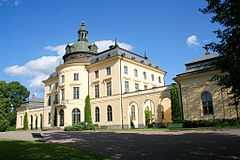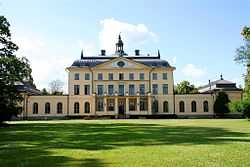Bjärka-Säby Castle
| Bjärka-Säby slott | |
|---|---|
 Front facade of the main building | |
| General information | |
| Architectural style | Baroque |
| Country | Sweden |
| Coordinates | 58°16′14″N 15°44′20″E / 58.2706°N 15.7390°ECoordinates: 58°16′14″N 15°44′20″E / 58.2706°N 15.7390°E |
| Construction started | 1791 |
| Completed | 1898 |

Bjärka-Säby Castle (Bjärka-Säby slott), also known as Bjärka-Säby Monastery (Bjärka-Säby kloster), is a baroque style château located south of Linköping, in Östergötland County, Sweden, that is an ecumenical monastery run by the Pentecostal Church.[1]
History
Bjärka-Säby Castle was built for Swedish diplomat and nobleman, Germund Louis Cederhielm. The building was based upon plans from a prominent Swedish landscape architect, Fredrik Magnus Piper. Construction started in 1791 and was completed just before 1800. The surrounding landscape was design in the manner of a traditional English park. The palace was subject to renovation in 1894-1898 based upon plans of architect Agi Lindegren (1858-1927). His work differ from Piper's design and resulted in a Baroque appearance.
Proposals for a restoration of the interior were advanced principally by Sigurd Curman, secretary of the Swedish National Heritage Board. Between 1920-1921, Eric Fant, architect at the Nordic Museum, conducted renovations reflecting the manor's origin in the late 1700s. The exterior has been allowed to retain the appearance resulting from the Agi Lindgren based conversion.
Since 1980, the château has been owned by Sionförsamlingen i Linköping, the Swedish Pentecostal movement's church in Linköping. This Pentecostal Monastery is ecumenical in nature, housing Christians of other Christian denominations as well, including Coptic Orthodox, Catholic, Lutheran and Evangelical Christians.[2]
Inside the monastery hangs portraits and icons of Hedvig Ekman, Gustaf Aulén, Nathan Söderblom and Bridget of Sweden, as well as the traditional Coptic icons of Mary and Jesus.[3] Other icons hanging in the monastery are those from the Russian Orthodox, Greek Orthodox, and Coptic Orthodox traditions.[3] Bjärka-Säby Monastery also has a patristic library, as well as a side chapel that was built in the 18th century, as a result of the devotion of the Pietist Lutheran Hedvig Ekman.[3]
The current abbot of the Pentecostal monastery is Peter Halldorf.
References
- ↑ "Not So Secular Sweden by Matthew Milliner". First Things. Institute on Religion and Public Life. June 2014. Retrieved 18 May 2014.
- ↑ "Not So Secular Sweden by Matthew Milliner". First Things. Institute on Religion and Public Life. June 2014. Retrieved 18 May 2014.
Continuing the ecumenical spirit, the castle, now known as Bjärka-Säby, hosts Coptic, Catholic, and Evangelical Christians as well.
- ↑ 3.0 3.1 3.2 "Not So Secular Sweden by Matthew Milliner". First Things. Institute on Religion and Public Life. June 2014. Retrieved 18 May 2014.
I gather my bags and descend a grand staircase, past family portraits going back generations, past neo-classical statues, past Coptic, Russian, and Greek Orthodox icons—their candles still flickering from the night shift. ... Still making my way to the exit, I pass a picture of influential theologians gathered on the castle steps a century ago. They include Gustaf Aulén, author of Christus Victor, and Lutheran Archbishop Nathan Söderblom, an ecumenical pioneer who worked with Catholics to revive devotion to Bridget of Sweden, one of Europe’s patron saints. ... On the table are a Coptic icon of Mary and her son, two candles, and two Swedish Psalters.
- This article is fully or partially based on material from Nordisk familjebok, Germund Louis Cederhielm and August (Agi) Lindegren.
- Edman, Victor (1999) En svensk restaureringstradition, (Stockholm: Byggförlaget) ISBN 91-7988-186-6
- Karling, Sten; Lindegren, Karin (1981) Fredrik Magnus Piper och den romantiska parken (Stockholm: Royal Swedish Academy of Arts) ISBN 91-86208-00-4
- Åman, Anders Sigurd Curman: riksantikvarie - ett porträt (Stockholm: Kungl. Vitterhets Historie och Antikvitets Akademien, Bokförlaget Atlantis, 2008) ISBN 978-91-7353-220-4